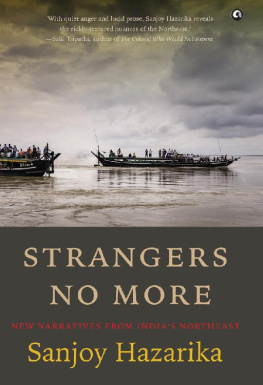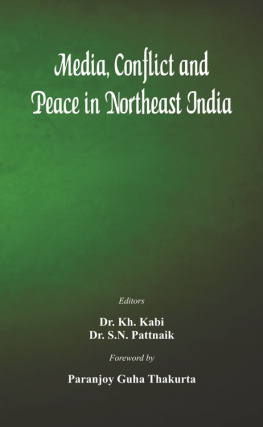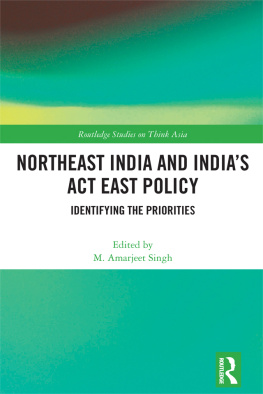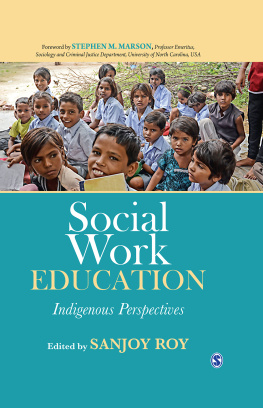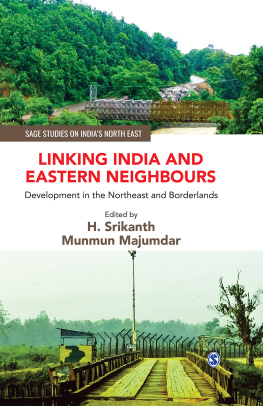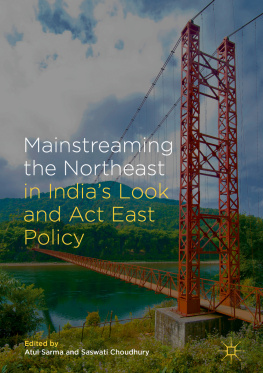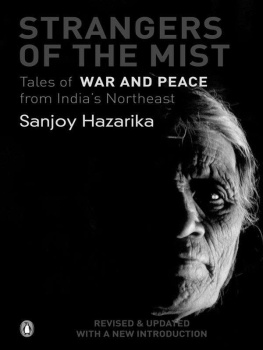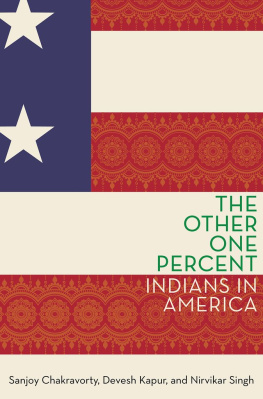STRANGERS
NO MORE
BOOKS BY SANJOY HAZARIKA
Strangers of the Mist: Tales of War & Peace from Indias Northeast
Rites of Passage: Border Crossings, Imagined Homelands, Indias East and Bangladesh
Writing on the Wall: Reflections on the North-East
Bhopal: The Lessons of a Tragedy
BOOKS EDITED BY SANJOY HAZARIKA
Hope Floats: The Boat Clinics of the Brahmaputra (with Bhaswati Khaund Goswami)
Gender Poverty and Livelihood in the Eastern Himalayas (with Reshmi Banerjee)
ALEPH BOOK COMPANY
An independent publishing firm
promoted by Rupa Publications India
First published in India in 2018
by Aleph Book Company
7/16 Ansari Road, Daryaganj
New Delhi 110 002
Copyright Sanjoy Hazarika 2018
The author has asserted his moral rights.
All rights reserved.
The views and opinions expressed in this book are the authors own and the facts are as reported by him, which have been verified to the extent possible, and the publishers are not in any way liable for the same.
No part of this publication may be reproduced, transmitted, or stored in a retrieval system, in any form or by any means, without permission in writing from Aleph Book Company.
ISBN: 978-93-84067-44-1
1 3 5 7 9 10 8 6 4 2
This book is sold subject to the condition that it shall not, by way of trade or otherwise, be lent, resold, hired out, or otherwise circulated without the publishers prior consent in any form of binding or cover other than that in which it is published.
For
Meghna, Ralf and Preeti
CONTENTS
AUTHORS NOTE
For years, I have wrestled with the idea of this book; stuttering efforts to start it came to naught. While I felt that I was not yet running out of time, I was certainly running out of ideas.
There have been acute challenges. The writing has been halting, arduous, especially after my wife Minal suddenly fell ill and then left us, all in a space of three months in early 2009. She was only fifty-six, and a powerhouse of energy, planning, curiosity and ability. For months after she passed away, I was unable to put pen to paper or even think of writing. A few months later, my son-in-law Ralf faced a challenge with cancer. My daughter Meghnas strength and love enabled him to overcome that crisis, as much as good treatment and early diagnosis. I was around to provide support in any way possible, keeping my sanity with daily walks, pranayama and yoga. Ralfs parents came from Germany at this difficult time and kept our spirits up with their energy and good cheer.
It takes time for people like me to realize that such challenges spur us to tell our stories better, weaving details and facts together, merging, mixing and remembering.
After years, my interest in the book revived. And as I began to resume writing, I was humbled by the vastness of what I do not know. I cannot but recall the words of that intrepid British explorer and botanist who walked into history with his legendary treks in search of fabled lands and rare plantsFrank Kingdon-Ward. He wrote: I am fully conscious that a complete account of the regions visited is a task beyond my power.
One of his unfinished tasks was the exploration of the Tsangpo Gorge through which the Yarlung Tsangpoknown as the Brahmaputra in Assamhurtles. This, too, is an incomplete challenge for me although I have travelled along the river through Tibet, Arunachal Pradesh, Assam and Bangladesh into the Bay of Bengal.
As the book developed, I realized it was important to weave stories of legend, imagination, future challenges and perspectives as well as personal experiences into a narrative flow. I have tried to do this as part of a frank introspection of where things have gone wrong or right and where they can be nudged to change. I felt that it would be useful to look at how, in my limited view, our region has both grown and unravelled after 19931994. Why those years, why this particular benchmark?
Because it was in the fall of 1993, possibly November, during a fellowship at the Joan Shorenstein Center at Harvard University, two decades ago, that the proof copy of my first book landed at the Centers reception and into my excited hands. I am aware that two decades and more may not be a long time in the history of a nation but it does give us an opportunity to look back, introspect and consider the future.
This is a deeply personal book, for it reflects what I regard as the core issues facing the eight Northeastern states of India: politics, policy, law and disorder, violent uprisings and painful reconciliations, offence and defence, conservation and oppression, history and the contemporary reality, stereotyping and breaking out of the mould, hope and despair.
I spend a fair amount of time looking at how new frontlines are emerging, of the new battlegrounds of discrimination and communalism, of the dangers of Islamic radicalism born out of prejudice as much as mobilization. There is too the relentless and ruthless exploitation of natural resources in the name of development and management, profiting a handful and pauperizing the vulnerable. In this I have focused on the struggle between political and commercial lobbies on one side and environmentalists, human rights campaigners, social scientists, researchers and writers on the other.
The structure of the book has developed along the following lines: a long introduction looks at borders, histories and notions of identity with a detailed study of the regions place in history and the struggles within and between Whitehall, New Delhi, Beijing and the Northeast itself, reflecting on intricate and opaque lines, frontiers and borders. These remain sharply contested and hugely problematic, especially in the IndiaChina sector, underlined by recurring clashes on the disputed border between the Asian giants. The first chapter begins with a death, the killing of Thangjam Manorama Devi in Manipur that provoked a public outcry and forced the Government of India, for the first time in its history, to review a national security law after a popular agitation. That was a democratic response to a democratic demand. However, the same cannot be said of what happened afterwards and the centres pusillanimous failure to follow up on the Justice Jeevan Reddy Committees report reviewing the Armed Forces (Special Powers) Act (AFSPA). That incapacity and official inchoateness has democratic incontinence stamped all over it. These are studied in detail, with personal narratives, official texts and a range of responses and documentation. AFSPA is a brief yet ponderous and powerful law, widely reviled as draconian. It has survived the wrath of Supreme Court judges who have virtually shredded the official position in powerful judgments. Yet its removal remains implacably blocked because the centre hasnt shown the guts, vision or trust thats needed for its revocation. I look at different aspects of conflicts in Manipur and provide a historical context to developments in Nagaland, bringing in personal experiences and interviews with the Naga militant leaders as well as ordinary people and peacemakers. The craft of peacemaking must be one of the most difficult in the world. Later in the book, I look at one example of it in Nagaland, unheard, unheralded, unsung and yet one that celebrates the triumph of courage and humility over hatred and suspicion in one of the states most influential villages.
I move to Mizoram, fleshing out the Mizo story of rage, resistance, retribution and reconciliation with many dramatis personae, building it around numerous figures and phases. Central to the narrative are Laldenga, who led the revolt, Lalthanhawla, the man who was Mizorams chief minister at the time of writing, and Sangliana or Lal Sangliana, the charismatic guerrilla leader. Sanglianas father, T. Sailo, was an Indian Army brigadier who went on to become chief minister of the state. We move to Assam and look at issues of migration and discrimination and the ubiquitous Bangladeshiboth in Nagaland and Assam, issues of prejudice come vividly to the fore as do questions of defining whos an Indian, an outsider or an immigrant. We revisit the fear of being overwhelmed by the illegal immigrant, an issue that I had looked at in depth both in Strangers of the Mist and Rites of Passage . Theres a chapter on the secret killings, patronized by the system, which maimed Assam and struck fear into the lives of many. A long look at the United Liberation Front of Assam (ULFA) follows, its connections to Bangladesh and the Bhutanese crackdown on it. The ubiquitous Paresh Baruah, who has managed to stay one step ahead of the security forces in India and Bangladesh, strides through these pages. The nature of the state at local and national levels as well as of armed groups and civil society actors are on test here and emerge clearly. I look at the new Indians and the impact of discrimination and prejudice towards them and also at how they respond in places such as New Delhi and back home. What is the trigger for the out-migration and who is moving out of the Northeast?



